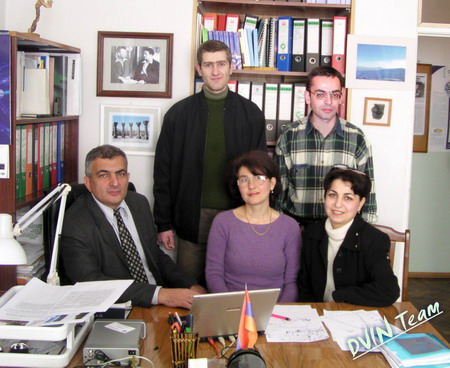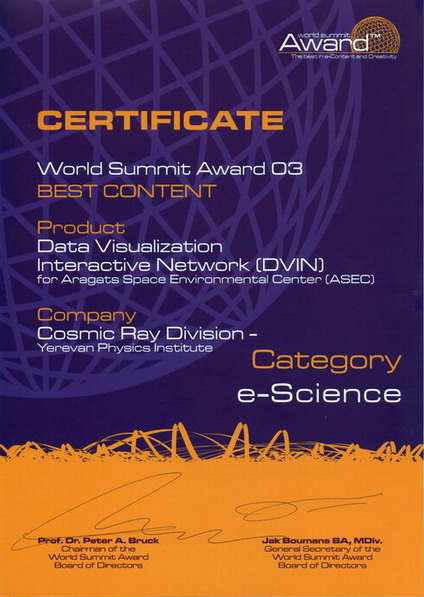Determined to Succeed, Armenia’s Cosmic Ray Division and Diaspora Move Forward Together
by Anahid Yeremian
February 6, 2004

President Kocharnian congratulates Prof. Chilingarian,
as he awards him the World Summit Award in the e-science category in
Geneva
As we close 2003 and begin a new year, it is a good time to reflect on our priorities and goals, measure our accomplishments and set standards for the future. As I reflect back, not only on the past year, but also on the past 4 years, I can say that one of the most significant events in my life was to visit Armenia in 1999 and experience the resolve of the Armenian people not only to survive, but also to excel and succeed in the face of many seemingly insurmountable obstacles. Their hospitality, which might suggest that they have all they need and so much more left over to shower on their guests, paints a rather deceiving portrait of the realities they face every day. I have developed a particularly tremendous respect for the people in Armenia who have the opportunity to emigrate out of Armenia because of their specialized skills, yet they choose to stay in the homeland, and contribute to its development at a rather high personal sacrifice.
The Cosmic Ray Division (CRD) of Yerevan Physics Institute in Armenia is one of these exemplary organizations, with a visionary leader in Prof. Ashot Chilingarian, and a responsible staff of 100 scientists, technicians, students and support personnel. It is this resolve on their part to not just exist, but to excel, that prompts us, the Diaspora, to continue to support them in every way that we can. Thus, the CRD research, with many practical applications, continues to make an international impact. The synergy between the Diaspora Armenians through their generous giving, and the staff and leadership of the CRD in Armenia through their diligent and outstanding contribution to advancement of scientific knowledge, has created a bond that cannot be broken. Together, the CRD in Armenia and the Diaspora, have achieved success after success on the international arena, putting Armenia and Armenian accomplishment back on the spotlight of the international community, creating jobs for the intellectuals in Armenia, and triggering social responsibility for Armenia Armenians to help those less fortunate than themselves.
Armenia’s Cosmic Ray Division scientists conduct state of the art research in high energy astrophysics, solar physics, and sophisticated data analysis methods. They operate 2 research stations on top of Mt. Aragats all year round, and have their headquarters in Yerevan. The staff rotates in 3-week shifts to man the mountain stations all year round. Prof. Ashot Chilingarian, is a visionary, hard-working leader, who requires no less from his staff and students. In addition to running the Cosmic Ray Division, Prof. Chilingarian teaches Physics at the Yerevan State University and has several students from the university who do their thesis work at the Cosmic Ray Division and are given the opportunity to work there after graduation. The staff consists of young, as well as, seasoned scientists who keep up with the rapid advances in technology and put it to efficient use at their research stations. These folks are truly shaping the future of science on a shoe string. What allows them to continue their science today is the same resolve that compelled them to preserve and protect their research stations and its property, at any cost, during the very difficult years of the early 90’s. Nothing, not even a teacup was removed from the mountain stations. When there was no salary and no food to eat, they continued their research anyway, and were supported by the very villagers who act as the domestic staff of the research stations. The villagers shared their meager means from their farms and animals with the scientists, so the scientists could continue their work.
Today, thanks to Diaspora support, which builds on the responsible and kind gesture of the villagers in the early 90’s, the CRD is building one scientific success on top of another. In 2003 the CRD established the Aragats Space Environmental Center (ASEC) in Armenia. Space weather is a very significant influence on our daily lives. It represents geomagnetic storms and particle showers that come to earth as a result of solar events, such as solar flairs and coronal mass ejections. The effect of the most severe of these events, when directed at earth, is to kill or damage our orbiting satellites, harm humans in space and on over the pole passenger flights, and burn transformers at power stations on the ground. The loss of these systems has far reaching consequences on human quality of life, and an early warning system to predict the arrival of these storms can help us to take mitigating action. In the past 3 years, the CRD has made tremendous progress in this field of research - establishing the world’s best ground based research station for it. Data from the ASEC ground based monitors on Mt. Aragats, combined with data from detectors on satellites, which are operated by NASA and the European Space Agency (ESA), will allow us to make early warning alerts to save our sensitive and expensive systems.
Because of the importance of the work by the Cosmic Ray Division scientists, this year the U.S. National Oceanographic and Atmospheric Agency’s Space Environmental Center (NOAA-SEC) has agreed to a scientific cooperation with ASEC. ESA has initiated dialog with Prof. Chilingarian and a similar scientific partnership between the CRD and the ESA is currently under way. Armenia has been accepted into the COST action 724. The European COoperation for Science and Technology (COST) action 724 aims at developing the scientific basis for monitoring, modeling and predicting Space Weather. Armenia is not only a participant in these multinational cooperations, but because of the expertise of the CRD scientists and Diaspora’s assistance to help them continue their work in Armenia, Armenia is one of the leaders in this field.
Perhaps one of the most significant recognitions for this persistent and unified synergy between and the Diaspora giving and CRD’s excellent utilization of it, is the World Summit on Information Society Award for best content in the e-science category, which the CRD won in December of 2003. The website, Data Visualization Interactive Network (DVIN), of ASEC was nominated for this prestigious award along with 800 other projects from 136 countries. A panel of experts from 36 countries, deliberated for a week, to name the winners.

Prof. Chilingarian, and the team of CRD scientists
and students
who created the World Summit Award winning web site DVIN.
Armenia received this award at a very special ceremony at the World Summit on Information Society in Geneva, attended by heads of state of many UN member countries and high level UN officials. President Kocharian did the honor of handing the award to the four finalists: Armenia, Canada, China, and the United States. The winning projects were displayed at the exhibition hall for 3 days during the summit, and will be displayed at various exhibitions around the world for the next 2 years.

The World Summit on Information Society Award
demonstrates the Cosmic Ray Division’s leadership in Space Weather
research.
On the other hand so many are the accomplishments of this teamwork between the CRD and the Diaspora patrons, that I have a hard time determining which is the more significant? Is it the World Summit Award, or is it the return of a very talented electronics engineer from Europe because he can earn a salary in Armenia. Or is it the fact that this seasoned engineer brings with him state of the art knowledge in microchip data acquisition systems and is training 4 of the students from Yerevan State University, who are doing their thesis work at the CRD, in this very important technology. Or could it be that the publication of 14 scientific papers by the CRD in refereed international scientific journals in the past 12 months demonstrates the new knowledge this group adds to the world supply, thus attracting new business opportunities in Armenia for industries that depend on brain power? Or is it the fact that when the Armenian Technology Group, inspired by the beautiful flowers on Mt. Aragats, donated some 20 beehives so that the CRD scientists could have sweet honey at the mountain stations, the scientists decided that 10% or more of it would be donated to orphanages and Soup Kitchens in Armenia and has consistently done so every year. Or is it the fact that, as we send better and better computers to the CRD to help the scientists with their CPU intensive calculations, they donate their older computers to schools in the villages and set up small computer labs for the village students, and volunteer their time to do this. I go round and round and I cannot decide which accomplishment is more important than the other? I have come to the conclusion that they are all important, and that all combined together have more added value than the sum of their value individually. This is why I love the words “unity” and “synergy”. Those words represent the much better results that we can achieve together, than apart. I want to wear these words like a permanent earring on each ear, such that I can be reminded daily how you the Diaspora have made all this possible for the Cosmic Ray Division scientists, and for Armenia.
Your continued financial support and the support of all those who are inspired by the achievements of the CRD on such a small shoe string budget are still needed. Please continue your partnership and we will keep you informed on a regular basis how your giving is making a difference. Prof. Ashot Chilingarian, the 100 scientists, technicians, students and support personnel of the CRD in Armenia and the Support Committee for Armenia’s Cosmic Ray Division thank you from the bottom of our hearts for your continued generosity and partnership. Please visit us at www.crdfriends.org and send us your comments and questions. Together we stand.